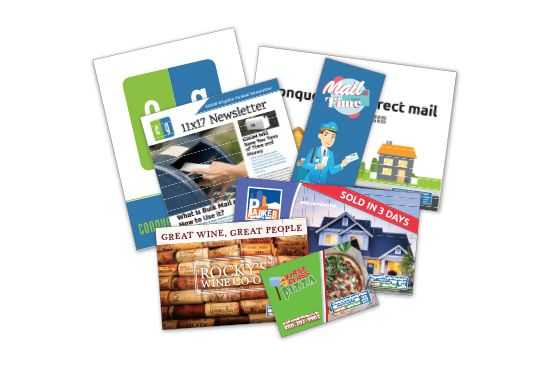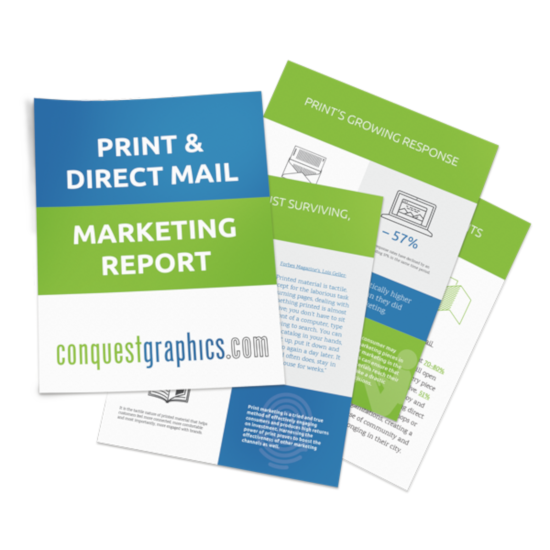
Print advertising remains a trusted and powerful medium for reaching audiences. As the digital world continues to progress, it’s essential that you use print ads to stand out and grow your business. Yet, you also need to maintain your online efforts to remain relevant and successful. But what happens when these two worlds collide? Results skyrocket.
Now, there are many ways to combine digital marketing with print. Still, there’s one simple solution that we have all seen in TV commercials, restaurants, and even instructional manuals: QR codes.
QR codes bridge print's physical nature and proven effectiveness with the measurability and adaptability of digital, creating a blend that caters to the needs of today’s audience.
In this blog, we’ll dive deep into the importance of QR codes in print advertising, exploring how they’re transforming how businesses connect with their audience while providing helpful tips and ways to take advantage of QR codes in print.
Why QR Codes are Important for Print Advertising

Print advertising has constraints in space and content volume. QR codes enhance print ads by bridging the digital world, enabling advertisers to provide comprehensive information, multimedia content, and interactive experiences without cluttering the physical ad. This fusion of print and digital enriches the user experience and enhances engagement and tracking capabilities for businesses.
Here is an overview of the many reasons why QR codes are essential for print advertising:
Overcoming Space Limitations
Because print has size limitations, you can only include certain information within your printed advertisement, or the ad’s design can quickly become overwhelming and ineffective. Including a QR code within your design can keep your design compelling and concise while still providing your audience with an easy means of learning more.
Instant Access to Digital Content
While emails, social media posts, and display ads are easily clickable to lead your audience somewhere to learn more, print materials aren’t clickable. Your audience needs to dial a phone number or type out an email address or website URL to learn more or to make a purchase. QR codes help by providing your audience with an easy, digital means of quickly learning more about a specific topic you’re sharing with them.
For example, if you’re mailing a product catalog, you have a small section to share details about each product. If you were to include QR codes for each product, your audience could easily visit the product details with a simple scan of their phone and even place an order directly from the product page you lead them to. This encourages immediate action and engagement with your audience.
Engaging Audience Interactions

Print advertisements such as brochures, catalogs, and postcards are already an interactive means of communication with their tangibility and physical nature. When you add a QR code for your audience to learn more about a topic or make a purchase, you provide them with an enhanced and quick way to interact and engage with your business.
Tracking and Analytics
You can measure the effectiveness of print advertising in several ways, including coupon cutouts, promo codes, or call tracking numbers. However, using a QR code is one of the easiest and most effective ways to understand audience engagement and conversion rates. By inserting a unique URL into your QR code, you can measure how many people scanned it by seeing how many people visited your webpage. From there, you can analyze how many visitors placed an order or left your page without purchasing.
Flexibility
Print advertisements aren’t changeable. In order to change contact information and other messaging, you need to redesign and reprint your materials. However, by hosting information that may require changes down the road on a webpage or app and then including a QR code within your print ad, you can update your content whenever needed without changing the print material.
Examples of QR Codes in Print Advertising

Table Tents
Table tents with printed QR codes have become increasingly popular, especially in the restaurant and healthcare industry. Restaurants commonly use QR codes on table tents to share daily specials or as complete menus. Healthcare providers will display table tents with QR codes in their waiting room, offices, or front desk to share important information with patients.
Business Cards
Including QR codes on business cards is a great way for prospects and customers to quickly and easily view your website. In addition, you can create vCard QR Codes where someone can scan the code with their smartphone, and your contact information is automatically saved to their contacts.
Catalogs
Catalogs have one of the highest purchasing rates compared to any marketing effort, and QR codes in catalogs can increase these rates. They can help your audience easily place orders online, quickly view product details, or find similar products with just a scan of their phone. You can even include special links within your QR code that automate a discount promo to entice your readers to scan and purchase.

Posters & Signage
Posters and other custom signage are made to grab a person's attention and quickly get a message across. Because of this, you need to avoid a lot of details. Your audience should understand what your sign is saying within only a couple of seconds. You also need a way to get your audience to take action easily, and including a QR code allows your audience to quickly scan it to learn more, sign up for an event, fill out a form, find your location, or make a purchase.
Direct Mail Postcards
Direct mail postcards are one of the most effective advertising tools available. They’re affordable and designed to drive immediate action. However, by adding a QR code that leads your postcard recipients to a specific webpage, you provide your audience with a quick way to take action, and you can easily measure the performance of your direct mail campaign.
Event Brochures
Event brochures are essential materials for various events, including charities, festivals, or corporate events. Adding QR codes to your event brochures is an excellent way for potential event attendees to buy tickets to your event quickly, get details on the itinerary, or view a parking map.

Promotional Calendars
Promotional calendars are a great way to promote your brand and engage with your audience all year long. To enhance the effectiveness of your calendar, include a QR code for each month. For example, you can promote a different product or service each month and pair specific sales or products for different seasons. For instance, a lawn care company could include a reminder to water your plants and a QR code that leads to their service request page during the middle of the summer. A restaurant could promote their in-season dishes for each corresponding month and a QR code to encourage their audience to place an order online.
Door Hangers
QR codes on door hangers are a great way to drive immediate action. And because they have limited space, including a QR code for people to scan to learn more is a great way to keep the door hanger design simple and clean.
Tips for Printing QR Codes
Ensure That the Code is Easily Scannable
To ensure your QR code is easily scannable, keeping its size no smaller than 0.8” x 0.8” is ideal. You also want to ensure that no other design elements interfere with the code. Include negative space around the code for optimal scanning ability.

In addition, sometimes URLs, like for blog posts, are very long. Placing these codes on small print ads, like a business card or postcard, can cause your codes to scan slowly and, for some phones, not at all. To ensure your QR codes scan fast, use a URL shortener so that your code has fewer characters for a smartphone or tablet to process.
Include a Call to Action
No one will scan the code if they don’t know where it leads. You need a compelling call to action or CTA encouraging your audience to scan the QR code. Provide them with details of where the code leads and clear instructions with an enticing incentive. For example, “scan the code to receive 20% off” tells the reader what to do and provides them with a reason to want to scan the code.
Customize its Design
QR codes are easily customizable. Depending on your QR generator, you can round the corners, change the color, and even add your logo or other imagery in the middle of the code. Because of this, it’s ideal to customize your QR code design to complement your printed design and align with your branding. Remember that your QR code should contrast against the background to ensure optimal scanning ability. For example, if the background color of your postcard is black, choose a white or very light color for your QR code.
Make Sure Linked Content is Mobile-Friendly
Because QR codes are scanned by smartphones and tablets, you need to ensure that the linked content you are leading your audience to is mobile-friendly. Ensure all elements on your webpage or app are easy to read and set up correctly for screens smaller than a desktop screen.
How Do I Add a QR Code to Print?
To ensure successful QR printing and to make sure your QR code is effectively displayed on your print advertisement, follow these steps:
Choose a Reliable QR Code Generator

Several great QR code generators out there are free, including QR Code Generator and QRCode Monkey. When choosing the best generator for your needs, pick one with good reviews and security measures.
If you’re using Adobe InDesign, you can generate your QR code directly from within the platform. However, companies specializing in generating QR codes offer more customization capabilities. So, choosing an online generator is ideal if you want to change the shape or add your logo.
Input the Desired Content
Insert your URL, contact information, or any other data you wish to share for your QR generator to process to create your code. If needed, shorten your URL and ensure the link or information is correct.
Personalize Your QR Code
Add brand elements like your logo if desired. Customize the frame, shape, and color to align with your print advertisement design and brand’s aesthetic while ensuring the QR code remains scannable.
Test the QR Code
Before downloading your QR code, use a scanner on your mobile device to test and verify that the code directs to the intended content.
Download the QR Code
Once you have tested your QR code and verified the correct destination, download your code in a high-resolution format like a PNG or an EPS to ensure clarity when printing.

Incorporate it into Your Print Design
Next, it’s time to place it into your design software appropriately within your print ad design. When adding the QR code to your print collateral, ensure it’s placed in a clear, uncluttered space. Also, ensure the printed size is large enough for easy scanning. Remember, the QR code size should be a minimum of 0.8” x 0.8.”
Print Your Materials
Finally, it’s time to bring your print advertisements to life. Export your design with your QR code from your design platform as a PDF. Then, look for a printer that offers free proofing so that before your pieces are printed, you can check one last time that your QR code works and links to the correct destination. If, by chance, your QR code isn’t working or the link is wrong, you can update your design and submit your artwork again until it is exactly how you need it to be before it goes through the printing process.
Conclusion: Increase the Effectiveness of Your Print Ads with QR Codes
As the digital age progresses, how we interact with printed advertising materials like signage, direct mail, and marketing handouts is rapidly evolving. QR codes are a bridge between these two channels, blending the tactile and proven success that comes with print and the dynamic capabilities of online platforms. They overcome space limitations in print advertising and increase audience engagement, making each printed material more interactive, measurable, and adaptable.
By offering a seamless transition from print to digital, QR codes effectively close the gap, making it easier for businesses to connect with their audience in a more meaningful way. As our behaviors shift towards instant gratification and digital interactions, QR codes in print advertising become an essential tool for businesses looking to benefit from the many advantages of print advertising while remaining relevant, trackable, and engaging.
If you’re ready to enhance your print advertising using QR codes, we’re here to help. At Conquest Graphics, we have everything you need, from design services to help you create a QR code printed piece to printing and mailing your advertisements. Click below to discover everything we have to offer to help you launch an effective print advertising campaign.
Explore Your Options Today!









